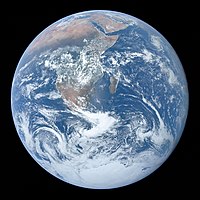
Photo from wikipedia
Understanding the possible climatic conditions on rocky extrasolar planets, and thereby their potential habitability, is one of the major subjects of exoplanet research. Determining how the climate, as well as… Click to show full abstract
Understanding the possible climatic conditions on rocky extrasolar planets, and thereby their potential habitability, is one of the major subjects of exoplanet research. Determining how the climate, as well as potential atmospheric biosignatures, changes under different conditions is a key aspect when studying Earth-like exoplanets. One important property is the atmospheric mass, hence pressure and its influence on the climatic conditions. Therefore, the aim of the present study is to understand the influence of atmospheric mass on climate, hence habitability, and the spectral appearance of planets with Earth-like, that is, N2-O2 dominated, atmospheres orbiting the Sun at 1 AU. This work utilizes a 1D coupled, cloud-free, climate-photochemical atmospheric column model; varies atmospheric surface pressure from 0.5 to 30 bar; and investigates temperature and key species profiles, as well as emission and brightness temperature spectra in a range between 2 and 20 μm. Increasing the surface pressure up to 4 bar leads to an increase in the surface temperature due to increased greenhouse warming. Above this point, Rayleigh scattering dominates, and the surface temperature decreases, reaching surface temperatures below 273 K (approximately at ∼34 bar surface pressure). For ozone, nitrous oxide, water, methane, and carbon dioxide, the spectral response either increases with surface temperature or pressure depending on the species. Masking effects occur, for example, for the bands of the biosignatures ozone and nitrous oxide by carbon dioxide, which could be visible in low carbon dioxide atmospheres. Key Words: Planetary habitability and biosignatures-Atmospheres-Radiative transfer. Astrobiology 18, 116-132.
Journal Title: Astrobiology
Year Published: 2018
Link to full text (if available)
Share on Social Media: Sign Up to like & get
recommendations!